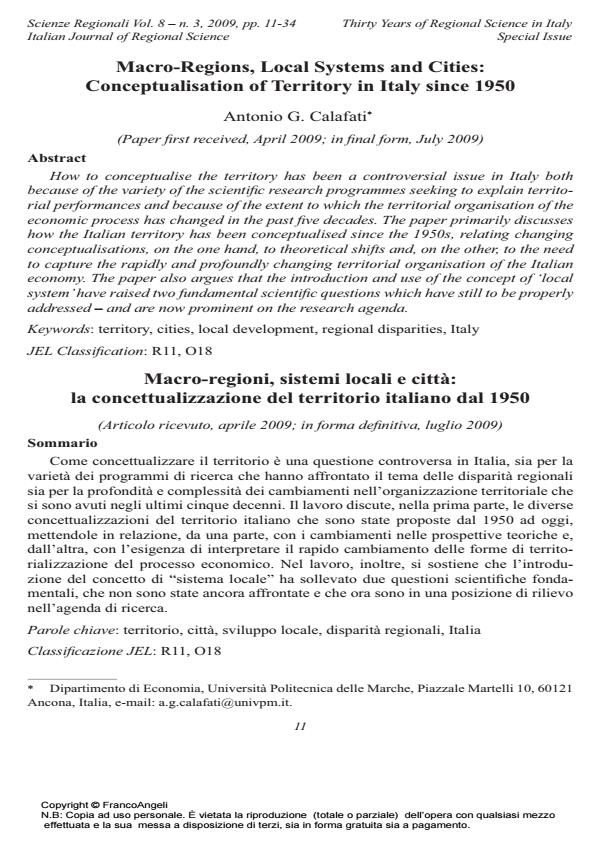Macro-Regions, Local Systems and Cities: Conceptualisation of Territory in Italy since 1950
Journal title SCIENZE REGIONALI
Author/s Antonio G. Calafati
Publishing Year 2009 Issue 2009/3
Language Italian Pages 24 P. 11-34 File size 342 KB
DOI 10.3280/SCRE2009-003002
DOI is like a bar code for intellectual property: to have more infomation
click here
Below, you can see the article first page
If you want to buy this article in PDF format, you can do it, following the instructions to buy download credits

FrancoAngeli is member of Publishers International Linking Association, Inc (PILA), a not-for-profit association which run the CrossRef service enabling links to and from online scholarly content.
Macro-Regions, Local Systems and Cities: Conceptualisation of Territory in Italy since 1950 - (Paper first received, April 2009; in final form, July 2009) How to conceptualise the territory has been a controversial issue in Italy both because of the variety of the scientific research programmes seeking to explain territorial performances and because of the extent to which the territorial organisation of the economic process has changed in the past five decades. The paper primarily discusses how the Italian territory has been conceptualised since the 1950s, relating changing conceptualisations, on the one hand, to theoretical shifts and, on the other, to the need to capture the rapidly and profoundly changing territorial organisation of the Italian economy. The paper also argues that the introduction and use of the concept of ‘local system’ have raised two fundamental scientific questions which have still to be properly addressed - and are now prominent on the research agenda.
Keywords: territory, cities, local development, regional disparities, Italy
JEL Classification: R11, O18
- Le Aree interne delle Marche: organizzazione territoriale e traiettorie di sviluppo Antonio Calafati, Francesca Mazzoni, Andrea Pizzini, Stefano Zoli, in PRISMA Economia - Società - Lavoro 1/2024 pp.21
DOI: 10.3280/PRI2024-001002 - The Long-Run Growth Trajectories of Third Italy's Cities: Empirical Evidence and Why Questions Antonio Calafati, in SSRN Electronic Journal /2014
DOI: 10.2139/ssrn.2399006 - Back to a future civilization: cities and countryside in the ‘Third Italy’ Francesco Bartolini, in Urban History /2021 pp.108
DOI: 10.1017/S0963926819000889 - Are medium-sized cities strong nodes in the settlement system? Demographic trends of Italian provincial capitals from 2000 to the Covid-19 pandemic Maria Antonietta Clerici, in Geographia Polonica /2023 pp.347
DOI: 10.7163/GPol.0240 - Questioning Polycentric Development and its Effects. Issues of Definition and Measurement for the Italian NUTS-2 Regions Paolo Veneri, David Burgalassi, in European Planning Studies /2012 pp.1017
DOI: 10.1080/09654313.2012.673566 - Is social polarization related to urban density? Evidence from the Italian housing market Valentina Antoniucci, Giuliano Marella, in Landscape and Urban Planning /2018 pp.340
DOI: 10.1016/j.landurbplan.2017.08.012 - The Metropolitan Question in Italy Antonio Calafati, in SSRN Electronic Journal /2016
DOI: 10.2139/ssrn.2877313 - Vettori di contaminazione e integrazione fra città e campagna: le aree metropolitane di area vasta Carlo Magni, in QUADERNI DI ECONOMIA DEL LAVORO 102/2015 pp.129
DOI: 10.3280/QUA2014-102010 - The identification of sub-centres in two Italian metropolitan areas: A functional approach Paolo Veneri, in Cities /2013 pp.177
DOI: 10.1016/j.cities.2012.04.006 - Denis Maillat, acteur et témoin d’un tournant de la recherche Roberto Camagni, in Revue d’Économie Régionale & Urbaine /2021 pp.13
DOI: 10.3917/reru.211.0013 - L'Area interna "Appennino Alto Fermano": uno studio di caso Antonio Calafati, Francesca Mazzoni, Andrea Pizzini, Stefano Zoli, in PRISMA Economia - Società - Lavoro 1/2024 pp.44
DOI: 10.3280/PRI2024-001003
Antonio G. Calafati, Macro-Regions, Local Systems and Cities: Conceptualisation of Territory in Italy since 1950 in "SCIENZE REGIONALI " 3/2009, pp 11-34, DOI: 10.3280/SCRE2009-003002